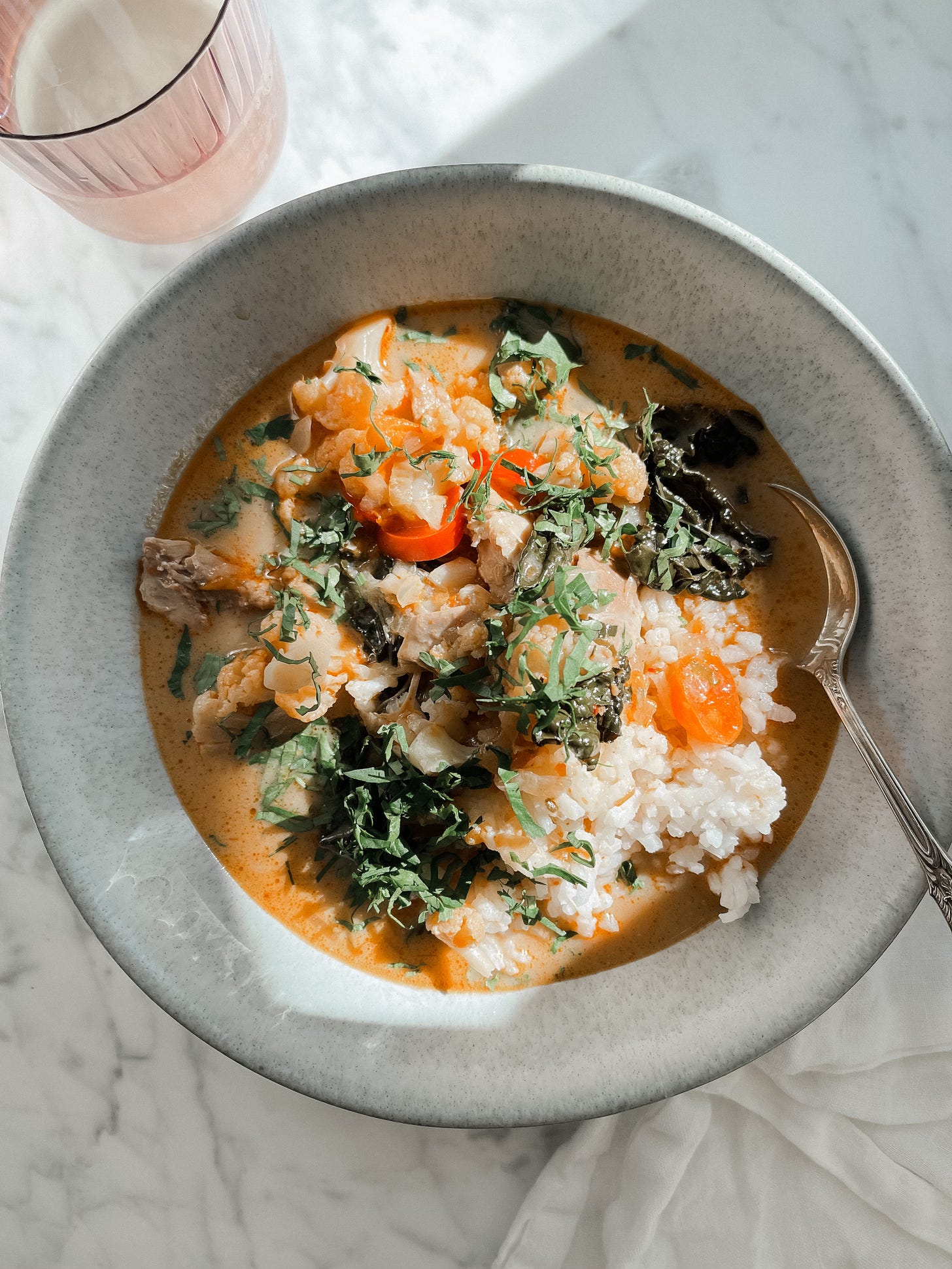Hello friends!
We’ve been settling back home after our travels. Theo started second grade this week, which feels impossible. School means back to routine, packing Theo’s lunchbox each day (and hoping it doesn’t come home full), and ensuring dinner is ready by 6ish. Which means easy-ish meals.
If you have a copy of Room at the Table, there’s a recipe called ‘Back-Pocket Braised Chicken,’ which is basically onions and garlic and chicken thighs and chicken stock cooked together until tender and then shredded. It’s the basis for a lot of my weeknight cooking, because it’s fairly quick. And from that base, you can make a million different dishes. Adding spices, tomatoes, peppers, rice and more chicken stock turns it into Arroz con Pollo. Adding green curry paste and coconut milk turns it into a Green Coconut Curry. You get the idea.
So, when I saw this recipe for Caramelized Gochujang Tomato Soup from Justine Snacks, I had an idea. Use the concept of the braised chicken with the caramelized gochujang and coconut milk and add a lot of vegetables. It worked. It’s deeply warming and satisfying. (By the way, if you don’t follow Justine on Instagram, I highly recommend doing so. Her videos are so good. And I want to eat everything she makes. I will be making this recipe for tomato soup, as is.)
If you haven’t tried gochujang yet, it is a fermented red chili paste used in Korean cooking. It is fragrant, pungent and spicy, adding depth of flavor and umami to dishes. One thing to note: most gochujang pastes contain wheat. I found this one on Amazon that is gluten-free.
And no, Theo does not eat this soup. I made him a side of fried tofu to go with the rice (and he ate a bunch of the raw kale while I was cooking). When he was little, he ate everything. Around age 3 or 4, he slowly became more…discerning. He won’t eat soup at all. Or spicy things. It pains me, but I trust it will eventually change. I’ve tried to follow Ellyn Satter’s advice on the division of responsibility with feeding kiddos, but it just hasn’t worked that well for us. Maybe you have better luck!
In any case, hope you enjoy the soup. And the coziness of these shorter, gently cooler days. I’ve started to acquiesce to fall and am begrudgingly enjoying the new edge of crispness in the air.
Next week, I’ll have an apple crumble recipe for you, because we have about a gazillion apples on our trees.
With love,
Lisa
Gochujang Coconut Chicken Soup
I always have a hard time writing titles for recipes. I really want to call this one: A Spicy Coconut Vegetable-Forward Chicken Soup with Caramelized Gochujang. Because that’s what it is. It’s also warming and satisfying.
Serves 6
1/4 cup extra-virgin olive oil
1 medium red onion, sliced
3 garlic cloves, thinly sliced
2 tablespoons gochujang (gluten-free, if needed)
1 pint Sungold tomatoes, halved (or other small tomatoes)
1 tablespoon tamari
1 pint chicken stock
1 13.5 ounce can full-fat coconut milk (this is my favorite brand, without gums)
1 1/2 pounds boneless, skinless chicken thighs
1 head cauliflower, cut into small florets
1/2 red pepper, sliced
1 small bunch kale, stemmed and torn into pieces
1/4 cup finely chopped cilantro and/or basil, plus more for serving
Chili crisp or chili oil, for serving (recipe for chili oil in Room at the Table)
Cooked white or black rice, for serving
Pour the olive oil in a medium dutch oven set over medium heat. Add the onion and garlic and cook, stirring occasionally, until the onion has completely wilted, about 10 minutes. If the onion looks like it’s going to brown, lower the heat.
Add the gochujang and stir. Cook, stirring often, for about 10 minutes or until the gochujang starts to caramelize on the bottom of the pan.
Add the tomatoes and tamari and stir, scaping up any bits of gochujang on the bottom of the pot. Cook for about 5 minutes, stirring occasionally, until the tomatoes have softened.
Add the chicken stock and coconut milk and stir. Bring the mixture to a boil and then reduce to a simmer. Add the chicken thighs, cauliflower, red pepper, kale and 1/4 cup of cilantro. Stir. Cover the pot and cook for 25 minutes, or until the chicken is cooked through and tender.
Remove the chicken thighs from the pot. Shred or chop the chicken thighs, and then return them to the pot and stir.
To serve, add about 1/2 cup of cooked rice to the bottom of a bowl. Add a couple of ladles of soup on top of the rice. Top with additional chopped herbs and a drizzle of chile oil, if you like.
Notes
In this recipe, I just add the chicken thighs to the liquid and braise. If you want to add an extra layer of flavor, brown the chicken thighs in the olive oil before adding the onions. Then remove them and add them back to the liquid with the vegetables and let them continue to cook. It will add even more flavor. But, since this is supposed to be an easy weeknight recipe, I took out that step.
You’ll also notice that there’s no salt in the soup! It’s not a mistake. That’s because the gochujang has salt and the tamari is salty. And your chicken stock might be salty. If you’re using a low-sodium chicken broth, you might want to add a little salt. But taste it first (after the chicken is fully cooked, of course).





YUM! We are overflowing with veggies from our garden right now - not a bad problem, but it can be a cooking challenge, for sure. I am going to make this tonight with our toms and maybe add a little zuch. Sounds SO good. Thanks for sharing the recipe!